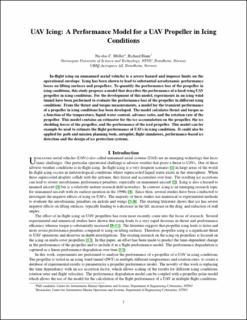| dc.contributor.author | Müller, Nicolas Carlo | |
| dc.contributor.author | Hann, Richard | |
| dc.contributor.author | Johansen, Tor Arne | |
| dc.date.accessioned | 2023-02-16T13:43:57Z | |
| dc.date.available | 2023-02-16T13:43:57Z | |
| dc.date.created | 2022-07-27T13:37:03Z | |
| dc.date.issued | 2022 | |
| dc.identifier.isbn | 978-1-62410-635-4 | |
| dc.identifier.uri | https://hdl.handle.net/11250/3051571 | |
| dc.description.abstract | In-flight icing on unmanned aerial vehicles is a severe hazard and imposes limits on the operational envelope. Icing has been shown to lead to substantial aerodynamic performance losses on lifting surfaces and propellers. To quantify the performance loss of the propeller in icing conditions, this study proposes a model that describes the performance of a fixed-wing UAV propeller in icing conditions. For the development of this model, experiments in an icing wind tunnel have been performed to evaluate the performance loss of the propeller in different icing conditions. From the thrust and torque measurements, a model for the transient performance of a propeller in icing conditions has been developed. The model calculates thrust and torque as a function of the temperature, liquid water content, advance ratio, and the rotation rate of the propeller. This model contains an estimator for the ice accumulation on the propeller, the ice shedding forces of the propeller, and the performance of the iced propeller. This model can for example be used to estimate the flight performance of UAVs in icing conditions. It could also be applied for path and mission planning tools, autopilot, flight simulators, performance-based ice detection and the design of ice protection systems. | en_US |
| dc.language.iso | eng | en_US |
| dc.publisher | American Institute of Aeronautics and Astronautics (AIAA) | en_US |
| dc.relation.ispartof | AIAA AVIATION 2022 Forum | |
| dc.title | UAV Icing: A Performance Model for a UAV Propeller in Icing Conditions | en_US |
| dc.title.alternative | UAV Icing: A Performance Model for a UAV Propeller in Icing Conditions | en_US |
| dc.type | Chapter | en_US |
| dc.description.version | acceptedVersion | en_US |
| dc.identifier.doi | 10.2514/6.2022-3903 | |
| dc.identifier.cristin | 2039796 | |
| dc.relation.project | Norges forskningsråd: 223254 | en_US |
| dc.relation.project | Norges forskningsråd: 321667 | en_US |
| dc.relation.project | Norges forskningsråd: 269228 | en_US |
| cristin.ispublished | true | |
| cristin.fulltext | postprint | |
| cristin.qualitycode | 1 | |
